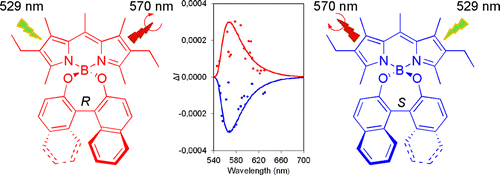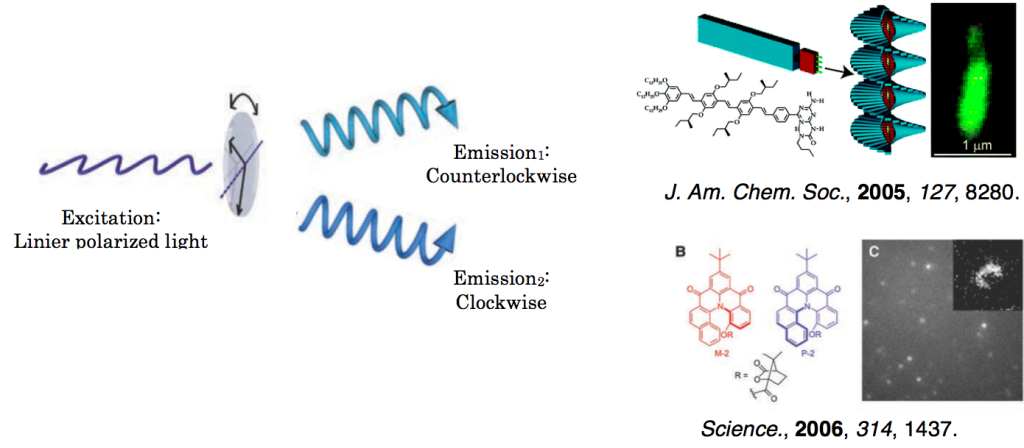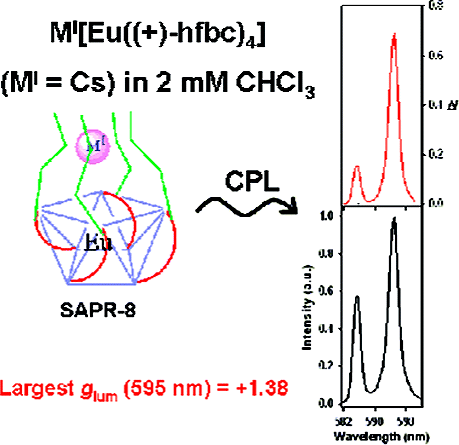E, Sanchez-Carnerero.; F, Moreno.; B, Maroto.; A, Agarrabeitia.; M, Ortiz.; B, Vo.; G, Muller.; S, Moya. J. Am. Chem. Soc. 2014, 136, 3346
DOI: 10.1021/ja412294s
Circularly polarized luminescence (CPL) in simple (small, nonaggregated, nonpolymeric) O-BODIPYs (R)-1 and (S)-1 by irradiation with visible light is first detected as proof of the ability of a new structural design to achieve CPL from inherently achiral monochromophore systems in simple organic molecules. The measured level of CPL (|glum|) in solution falls into the usual range of that obtained from other simple organic molecules (10−5 − 10−2 range), but the latter having more complex architectures since axially chiral chromophores or multichromophore systems are usually required. The new design is based on chirally perturbing the acting achiral chromophore by orthogonally tethering a single axially chiral 1,1′-binaphtyl moiety to it. The latter does not participate as a chromophore in the light-absorption/emission phenom- enon. This simple design opens up new perspectives for the future development of new small-sized CPL organic dyes (e.g., those based on other highly luminescent achiral chromophores and/or chirally perturbing moieties), as well as for the improvement of the CPL properties of the organic molecules spanning their use in photonic applications.
Introduction
Circularly Polarized Luminescence (CPL), also known as fluoresncece-detected circular dichroism (FDCD), is namely polarized emission from chiral molecule. Simple and explanatory figures are shown below. CPL holds many practical aspects such as information processing, microscope and so on. The intensity of CPL is often measured in absolute terms of |glum|. Although large |glum| value have been achieve in many studies,[1] simple yet small molecules that show CPL are still limited. In this work, BODIPY that is now indispensable organic dye in many fields can be easily modified to exhibit the CPL.
Molecular design and spectrum
Commercially available BODIPY (PM567) was used as starting compound. Target compound (R)-1 and (S)-1 was synthesizedby nucleophilic substitution with commercial (R)- and (S)-1,1′-bi(2-naphtol) (BINOL) respectively. Measurement of CPL revealed that each gabs was − 0.00093 and + 0.00074 which is moderate value for a small chiral dye.
References
[1]”Extraordinary Circularly Polarized Luminescence Activity Exhibited by Cesium Tetrakis(3-heptafluoro-butylryl-(+)-camphorato) Eu(III) Complexes in EtOH and CHCl3 Solutions” Lunkley, J. L.; Shirotani, D.; Yamanari, K.; Kaizaki, S.; Muller, G. J. Am. Chem. Soc. 2008, 130, 13814−13815. DOI: 10.1021/ja805681w
The largest CPL activity ever measured was observed for cesium tetrakis(3-heptafluoro-butylryl-(+)-camphorato) Eu(III) complexes in EtOH and CHCl3 solutions substantiating the stereospecific formation of chiral Δ-SAPR-(C4) configuration with the aid of Cs+···FC (fluorocarbon) interactions more clearly than the exciton CD spectra.




